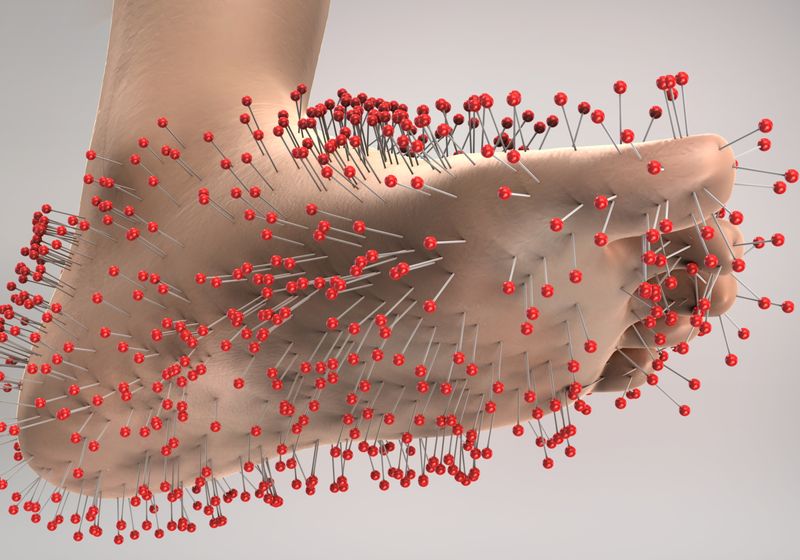Nerves overreact after being cut off from their blood supply, causing tingling sensations.
After an intense typing session or lengthy binge-watching marathon on the couch, people often lose feeling in one of their limbs. At first, the appendage is numb to the touch. Then, as a person shifts their position, releasing the limb from a cramped angle, they experience tingling, often known as the “pins and needles” sensation or paresthesia.
“Ultimately, at its root, it is the firing of neurons in the peripheral nervous system when they otherwise shouldn’t be,” said Andrew Shepherd, a neuroimmunologist at the University of Texas MD Anderson Cancer Center. While pins and needles after a prolonged period of being bunched up in one spot is a temporary experience, Shepherd studies how the immune system interacts with the nervous system in chronic cases of neuropathy, which can include this sensation.
Why Does Your Leg Sometimes Fall Asleep?
Andrew Shepherd studies how the immune system interacts with the nervous system to cause chronic pain.
Andrew Shepherd
For transient pins and needles sensations, Shepherd explained that the main culprits for the prickling feeling are large-diameter axons that respond to light, non-painful pressure. These nerves are surrounded by thick layers of myelin, allowing them to send messages rapidly. “It really comes down to compression of that nerve,” Shepherd said.
Even when nerves are not firing, they rely on a steady supply of fresh blood to maintain homeostasis. When a person compresses their limb, they cut off the cells’ access to oxygen and glucose.1-3 This leads to a drop in ATP production and availability, which is needed to pump sodium ions out of the cell to maintain the voltage across the membrane. In response, the cell stops firing; this, Shepherd said, is where the dead limb sensation comes from.
When a person shifts and releases their limb, oxygen and glucose rush back into the area, and calcium ions flood into the cell as sodium begins to be pumped out. However, because of the increased positive charge in the cell, it becomes more excitable, making it more likely to fire.4 “That is what actually drives this abnormal activity,” Shepherd explained.
Paresthesia in Neuropathy
As a result of this hyperexcitability, the nerves begin firing in the absence of stimuli, and people experience this as a pins and needles sensation. In a healthy neuron, the cell self-regulates, closing the channels and lowering its excitability threshold. This halts the production of signals and, in turn, the tingling sensations a person feels.
If a nerve is damaged, though, then this mechanism may not function correctly. Shepherd said that dysfunctional mitochondria are involved in many neuropathies.5-8 While this can have many effects on the cells, it can decrease the availability of ATP needed to pump ions into and out of the cell. As a result, the nerve can become more excitable, increasing the likelihood of it firing. However, unlike in the transient example, this improper firing continues for prolonged periods of time in chronic conditions.
- Weddell G, Sinclair DC. “Pins and needles”: Observations on some of the sensations aroused in a limb by the application of pressure. J Neurol Neurosurg Psychiatry. 1947;10:26-46.
- Vereschagin KS, et al. Transient paresthesia in stair-climbers’ feet. Phys Sportsmed. 1993;21(2):63-69.
- Fox JL, Kenmore PI. The effect of ischemia on nerve conduction. Exp Neurol. 1967;17(4):403-419.
- Mogyoros I, et al. Mechanisms of paresthesias arising from healthy axons. Muscle Nerve. 2000;23(3):310-320.
- Eid SA, et al. New perspectives in diabetic neuropathy. Neuron. 2023;111(17):2623-2641.
- Persson AK, et al. Sodium channels, mitochondria, and axonal degeneration in peripheral neuropathy. Trends Mol Med. 2016;22(5):377-390.
- Chen Y, et al. Dysregulation of mitochondria, apoptosis and mitophagy in Leber’s hereditary optic neuropathy with MT-ND1 3635G>A mutation. Gene. 2024;930:148853.
- Bernard-Marissal N, et al. Altered interplay between endoplasmic reticulum and mitochondria in Charcot–Marie–Tooth type 2A neuropathy. Proc Natl Acad Sci USA. 2019;116(6):2328-2337.

